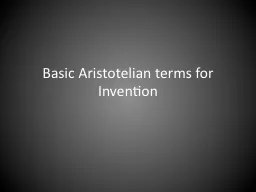

Ethos The Persuasiveness of Character Ethos The term originally meant way of life or dwellingabode and shares the root of the words ethicsethical and ethnic Ethos The term originally meant way of life or dwellingabode and shares the root of the words ID: 782793
Download The PPT/PDF document "Basic Aristotelian terms for Invention" is the property of its rightful owner. Permission is granted to download and print the materials on this web site for personal, non-commercial use only, and to display it on your personal computer provided you do not modify the materials and that you retain all copyright notices contained in the materials. By downloading content from our website, you accept the terms of this agreement.
Slide1
Basic Aristotelian terms for Invention
Slide2Ethos: The Persuasiveness of Character
Slide3Ethos
The term originally meant “way of life” or “dwelling/abode” and shares the root of the words
ethics/ethical
and
ethnic.
Slide4Ethos
The term originally meant “way of life” or “dwelling/abode” and shares the root of the words
ethics/ethical
and
ethnic.
Aristotle says that among all the elements of persuasion, it is the
ethos
of the speaker that tends to be the most influential.
Slide5Ethos
Audiences seek demonstrations of the speaker’s
Slide6Ethos
Audiences seek demonstrations of the speaker’s
Good judgment: Do you grasp things appropriately, make good decisions, are you wise and balanced in your views?
Slide7Ethos
Audiences seek demonstrations of the speaker’s
Good judgment: Do you
grasp
things appropriately, make good decisions, are you wise and balanced in your views?
Good will: Do you have the audience’s best interests at heart?
Slide8Ethos
Audiences seek demonstrations of the speaker’s
Good judgment: Do you
grasp
things appropriately, make good decisions, are you wise and balanced in your views?
Good will: Do you have the audience’s best interests at heart?
Good character: Do you provide a model to emulate?
Slide9Ethos
Slide10Ethos
At minimum:
establish your credibility to speak on the subject.
A more advanced approach
: demonstrate your good judgment, good will, and good character.
The best
:
speakers cultivate an unmistakable personal style that animates the whole speech and gives
us
a new way to be.
Slide11Pathos: The Persuasiveness of Emotions
Slide12Pathos
Shares root of the word
passion
and
passive
. To feel
pathos
means to be “touched” by the language of the speaker.
Slide13Pathos
Shares root of the word
passion
and
passive
. To feel
pathos
means to be “touched” by the language of the speaker.
According to Aristotle,
pathe
are not “irrational” or unpredictable. A speaker can deliberately cultivate specific moods and, from there, influence an audience’s judgment.
Slide14Pathos
Good speakers add elements to a speech that put the audience in a “mood.”
Fear-Confidence
Love-Hate
Anger-Calm
Shame-Pride
Pity-Contempt
Slide15Pathos
Good speakers add elements to a speech that put the audience in a “mood.”
Angst, boredom, depression, despair, duty, embarrassment, faith, friendship, frustration, gratitude, guilt, hope, indifference, innocence, jealousy, joy, loss, mourning, nihilism, pride, regret, remorse, respect, sadness, self-respect, vanity, zeal and more…
Slide16Pathos
Pathos is often cultivated through
concrete
language
and
sensory detail
.
Slide17Pathos
Slide18Pathos
At minimum
: Add emotionally attuned passages to one or more main points.
A more advanced approach
: Seek to stir specific moods in the audience that might shape their judgment.
The best
:
speakers cultivate a palpable emotional energy in the speech that gives the audience a kind of embodied “thrill” and awakens new emotional responsiveness and new ways to feel.
Slide19Logos: The persuasiveness of good Reasons
Slide20Logos
The word originally meant “gathering” in a way that allows what is there to stand out.
Slide21Logos
The word originally meant “gathering” in a way that allows what is there to stand out.
We find
logos
used as a suffix (e.g. psycho
logy
, anthropo
logy
, bio
logy
).
Slide22Logos
The word originally meant “gathering” in a way that allows what is there to stand out.
We find
logos
used as a suffix (e.g. psycho
logy
, anthropo
logy
, bio
logy
)
And it is the word for “Word” in the Christian tradition.
Slide23Logos
For this class, we will consider
logos
primarily as a way thinking about the importance of building strong
arguments
.
Slide24Logos
For this class, we will consider
logos
primarily as a way thinking about the importance of building strong
arguments
.
Logos in this sense deals with what is
likely
and
reasonable
…not “logical” and “necessary.”
Slide25Slide26Argument
Argument is an attempt to inspire
judgment
in an another about something
uncertain
using
reasons
drawn from what the audience
already
knows and believes.
Slide27Parts of an Argument
Claim: A statement about something uncertain
Slide28Parts of an Argument
Claim: A statement about something uncertain
Reason: Why we should agree
Slide29Parts of an Argument
Claim: A statement about something uncertain
Reason: Why we should agree
Evidence: What facts support the reason
Slide30Parts of an Argument
Claim: A statement about something uncertain
Reason: Why we should agree
Evidence: What facts support the reason
---------------------------------------------------------------
Warrant: Underlying (often implicit, common sense) assumptions that make the claim/support plausible
Slide31Parts of an Argument
Claim: That guy is not boyfriend material.
Slide32Parts of an Argument
Claim: That guy is not boyfriend material.
Reason:
Evidence:
----------------------------------------------------------
Warrant:
Slide33Parts of an Argument
Consider counterarguments at the level of the reasoning or underlying warrant.
Slide34Parts of an Argument
Claim:
Reason:
Evidence:
----------------------------------------------------------
Warrant:
Slide35Typical Kinds of Arguments
Definition
Similarity
Difference
Degree
Consequence
Slide36Logos
At minimum:
Consider what your audience is likely to find reasonable and plausible.
A more advanced approach
: Write an array of arguments tailored to the specific audience; consider the underlying warrants and prepare to refute counter-arguments.
The best
:
speakers give us new ways of reasoning, new truths, or new ways to affirm our truths.
Slide37Putting it all together
"Before I Die"